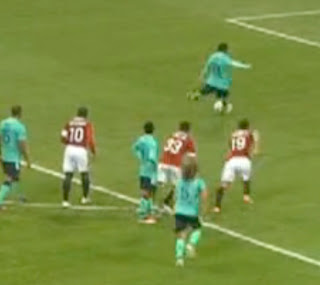The following incidents occurred during the
UEFA Champions League group match beween AC Milan and Barcelona on 23 November 2011. The match finished 2—3.
Application of the Laws1) CORRECT
In the 24', AC Milan player Alberto Aquilani (red 18) recklessly kicked Barcelona's Cesc Fabregas (blue 4). Referee Wolfgang Stark correctly cautioned Aquilani.

In the 30', Referee Wolfgang Stark awarded a penalty to Barcelona. This for a foul by Aquilani on Barcelona's Xavi.


2) INCORRECT
There was no caution
* awarded to Aquilani (and hence Aquilani was fortunate not to be sent off for second cautionable offence), which is incorrect. Instead, a yellow card was given to AC Milan's Alessandro Nesta (red 13). The reason(s) for this is unclear. However, whether it was a case of mistaken identity or for dissent, this incident again highlights the
ineffectiveness of extra assistant referees (EARs) who in this match clearly did not help the hapless referee.
 *
* Perhaps even a red card for DOGSO
At the highest levels, the difference between whether or not an obvious goal scoring opportunity is denied can be due to a yard or two. For example, in a similar incident in a match between Real Madrid and Atletico Madrid on 26 November 2011, the Referee dismissed Atletico's goalkeeper for DOGSO (comparing the
two freeze frames below, it appears that the attacking player's distance to the ball is the determining factor here ... a matter of a couple of yards?).


3) CORRECT
During the penalty kick, Barcelona's Lionel Messi should have known better than to stop at the end of his run up.
 Lionel Messi stops at the end of his run up
Lionel Messi stops at the end of his run up
Note: isn't it wonderful to see so many players (especially the slighted team) who did not hesitate to display their knowledge of the updated Laws of the penalty kick. The Referee correctly ordered a retake and correctly cautioned Messi for unsporting behaviour.
 AC Milan goalkeeper Christian Abbiata knows the updated Law ... how convenient!
AC Milan goalkeeper Christian Abbiata knows the updated Law ... how convenient!
But isn't it interesting that players ignore the Law about encroachment during penalty kicks?
4) FOR CONSIDERATION
During both penalty kicks, look at AC Milan's Gianluca Zambrotta (red 19). He encroaches both times.
 Messi's penalty re-take (look at red 19)
Messi's penalty re-take (look at red 19)
The
consideration is whether the Referee or his assistants would identify this encroachment had the penalty kick not been converted? Now that there are 3 match officials present during penalty kicks, it is surprising that their presence is not used optimally to help prevent encroachment. See previous post (
Europa League Penalty Kicks and Encroachment).
Application of Competition RulesI know this is not a strict ruling, but match officials in the Champions League have an official referees kit specific to this competition. They are therefore expected to wear them. For example, here are some of the UCL referee kits:
 Arsenal vs Borussia Dortmund (2011 UCL Adidas referees kit)
Arsenal vs Borussia Dortmund (2011 UCL Adidas referees kit)
 Bayer Leverkusen vs Chelsea (2011 UCL Adidas referees kit)
Bayer Leverkusen vs Chelsea (2011 UCL Adidas referees kit)
 AC Milan vs Barcelona (2010 WC Adidas referees kit)
AC Milan vs Barcelona (2010 WC Adidas referees kit)
INCORRECT
It was strange therefore to see Referee Wolfgang Stark and his team wear the 2010 World Cup Adidas referees kit. I wonder what the problem was? Did one of the match officials forget their specific UCL referees kit? But then why did the match officials also have the 2010 WC referees kit with them when they knew they were officiating in a UCL match? Or had one of the match officials not yet received his UCL referees kits?
There are particular and there are peculiar competition rules regarding referees kits, although they may not be officially documented. For instance, in the past we have seen an unwritten preference toward a certain colour of referee kit (i.e. the cyan-blue 2010 WC referees kit during the 2009-2010 Europa League competition; see
Blue is the ‘New Black’ in the Europa League).
The
match officials were:
Referee Wolfgang Stark (GER)
Assistant referees Jan-Hendrik Salver (GER), Mike Pickel (GER)
Fourth official Peter Gagelmann (GER)
Additional assistant referees Peter Sippel (GER), Christian Dingert (GER)
 Referee Mike Jones initially signalled a corner kick to Newcastle Utd but then accepts AR John Flynn's decision to overrule for a penalty kick against Man Utd
Referee Mike Jones initially signalled a corner kick to Newcastle Utd but then accepts AR John Flynn's decision to overrule for a penalty kick against Man Utd


































